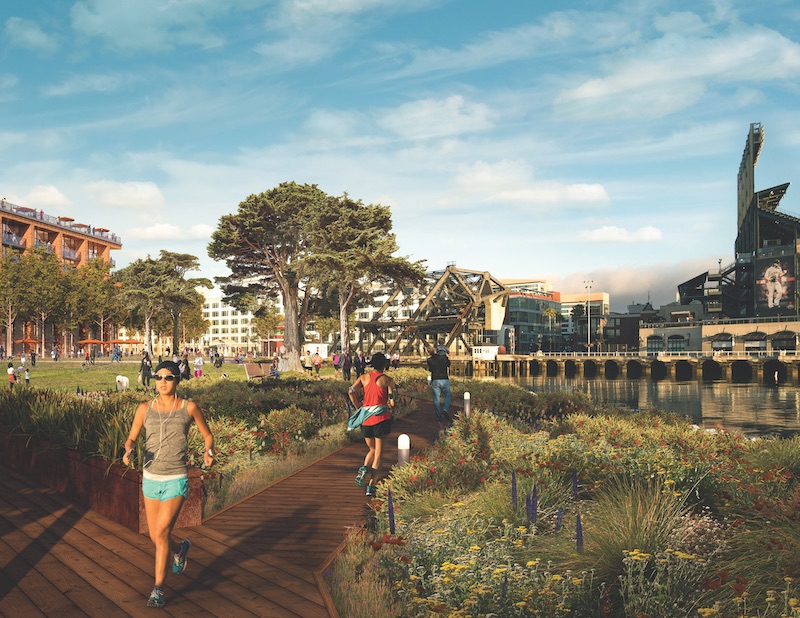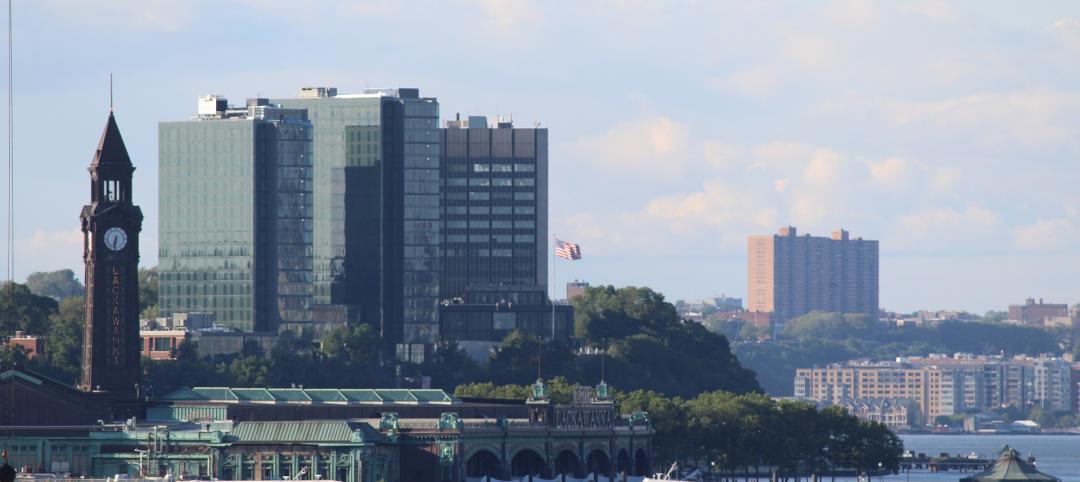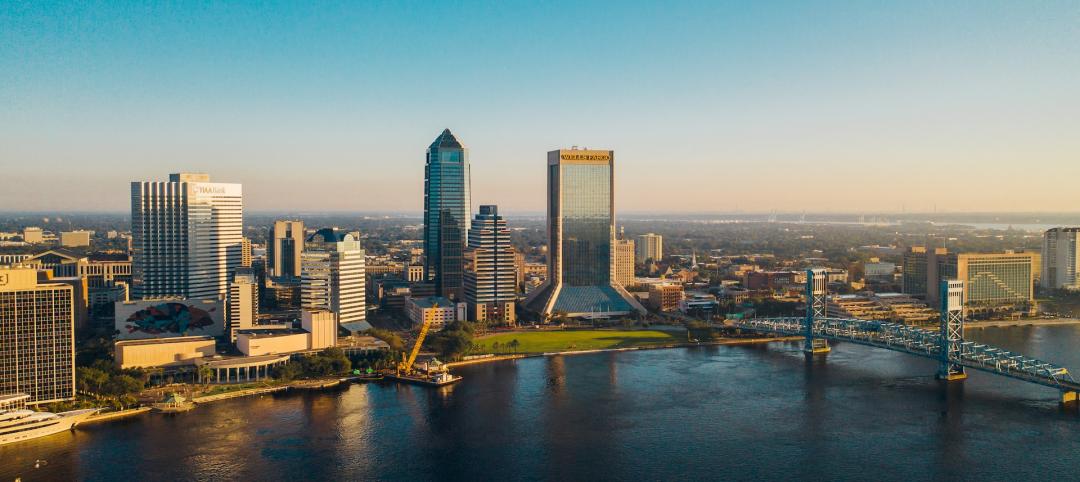On July 28, the New Jersey Department of Environmental Protection awarded AECOM and a team that includes OMA, Magnusson Klemencic Associates, and Matrix New World Engineering the final design contract for a resilience project along the Hudson River. The primary goal is to reduce flooding in Hoboken, which has 2.3 miles of coastal exposure, and parts of Weehawken and Jersey City.
The approach of this project, which HUD awarded $230 million through its Rebuild by Design contest, has four integrated resilience components:
- Resist, through a combination of hard infrastructure like bulkheads and floodwalls, and soft landscaping like berms that might double as parks.
- Delay, through policy changes and infrastructure that slow stormwater runoff.
- Store, with green and gray infrastructure improvements, such as bioretention basins and swales, to capture stormwater.
- Discharge, by enhancing stormwater management systems and upgrading infrastructure such as sewer lines.
Skidmore, Owings & Merrill, which is working on a separate project to redevelop Hoboken’s Terminal and Rail Yard into a mixed-use transit-oriented community with more than $100 million in improvements, is coordinating its efforts with the Rebuild by Design team, whose study area encompasses the terminal/rail yard.
Projects like these, where resilience is central to their design and construction, are becoming more commonplace, as developers and their AEC teams adopt positive measures to give their property assets a fighting chance of surviving the ravages of natural disasters, and to minimize recovery costs.
The replacement Ocosta Elementary School in Westport, Wash., which opened in the fall of 2016, offers a safe haven of refuge to students and residents who would have less than 30 minutes to evacuate in the event of a tsunami. The 23-classroom school includes the first vertical shelter in North America, a rooftop evacuation platform 53 feet above sea level that’s accessible via four flanking stair towers enclosed in concrete.
The platform, which is anchored by concrete piles that extend 55 feet into the ground, can hold more than 1,000 people and withstand a 9.2-magnitude earthquake and the impact of incoming waves. Resilience accounted for $2 million of the school’s $16 million project cost.
Three-thousand miles to the east, a seven-acre site with 1,700 lineal feet of shoreline along East Boston’s waterfront is being transformed into Clippership Wharf, a mixed-used development that will have 478 apartment units on two finger piers. Owner/developer Lendlease took over this project from a previous developer that had planned for lots of surface and underground parking. “That’s just not right for this day and age,” says Nick Iselin, Leadlease’s General Manager of Development. Lendlease rewrote the plan with several resilience measures, including replacing old seawalls that had been part of the site’s industrial infrastructure.
Lendlease is converting one of the piers into a “living shoreline” by creating a series of terraces for new salt marshes and a habitat for Boston Harbor, which is subject to a 10-foot tidal influence. The first floor of each building will be 24 feet above Boston City Base. All infrastructure and mechanical systems will be located above the 100-year flood level. Garage levels will be flood resistant.
To meet Boston’s “Living with Water” ordinance, Lendlease created a 1,400-foot Harbor Walk that will be 14-16 feet above the water level. In all, Clippership Wharf will have 189,830 sf of open space.
Back on the West Coast, there’s a 28-acre parking lot south of AT&T Park, where the San Francisco Giants play, that is subject to sea levels that vary as much as 24 inches. Predictions estimate those levels could rise to 66 inches by 2100.
“We needed to manage that risk,” says Kristen Hall, LEED AP, Senior Urban Designer with Perkins+Will, which has written the design controls for the proposed mixed-used redevelopment of this waterfront site, called Mission Rock. Eventually, it will encompass 11 city blocks and include eight acres of parkland, 1,500 rental units, and a million sf of office space. The Giants and the Port of San Francisco are co-developers.
The design, Hall explains, calls for the creation of a mesa down the middle of the site, with minimal frontages that may flood. She calls these frontages the site’s “sacrificial edges.” Other edges will include loading docks that create redundant elevated building access, as the majority of Mission Rock’s buildings would be at higher elevations. The park area would use a series of grade changes as design features, such as an amphitheater, a sloped lawn, steps, and ramps.
In July, the first phase of the Cornell Tech applied science campus was completed on Roosevelt Island in New York City’s East River. That phase includes The House, a residential complex with 350 apartments for staff and faculty, and Bloomberg Center, a four-story, academic building.
The buildout of this 12.4-acre, $2 billion campus is expected to proceed through 2043 and expand to two million sf. SOM, in collaboration with Cornell University and Technion – Israel Institute of Technology, is the project’s master planner. Resilience is key to protecting this property.
Colin Koop, AIA, SOM’s Design Director, explains that the East River is a tidal estuary, and significant portions of the site lie within 100- and 500-year floodplains. So all of the architecture needs to be elevated. The main pedestrian walkway, called Techwalk, will allow people to enter the campus at its periphery and then rise gently through its open spaces at a slope that is largely imperceptible. Once they reach the central ridge, they would be surrounded by permeable façades “that help create a synergy between inside and outside spaces on campus,” he says.
Cornell, says Koop, has been a “sophisticated client that is grappling with realities larger than itself and this project.”
Related Stories
Resiliency | Jan 2, 2024
Americans are migrating from areas of high flood risk
Americans are abandoning areas of high flood risk in significant numbers, according to research by the First Street Foundation. Climate Abandonment Areas account for more than 818,000 Census Blocks and lost a total of 3.2 million-plus residents due to flooding from 2000 to 2020, the study found.
Sustainability | Jan 2, 2024
Los Angeles has plan to improve stormwater capture and source 80% of water locally
Los Angeles County’s Board of Supervisors voted for a plan to improve stormwater capture with a goal of capturing it for local reuse. The plan aims to increase the local water supply by 580,000 acre-feet per year by 2045.
75 Top Building Products | Dec 13, 2023
75 top building products for 2023
From a bladeless rooftop wind energy system, to a troffer light fixture with built-in continuous visible light disinfection, innovation is plentiful in Building Design+Construction's annual 75 Top Products report.
Codes and Standards | Nov 27, 2023
Hoboken, N.J.’s street design policies are saving lives
Transportation policies enacted in Hoboken, N.J. over the past several years are paying off in the form of fewer pedestrian deaths and injuries. The city has adopted daylighting, bike lanes, lower speed limits, and intersection redesigns to make its roads safer.
Resiliency | Nov 27, 2023
All levels of government need to act to cope with climate-driven flooding and sea level rise
The latest National Climate Assessment highlights the need for local, state, and federal governments to adopt policies to mitigate the effects of climate-driven flooding and sea level rise, according to a policy expert with the National Resources Defense Council.
Resiliency | Nov 16, 2023
How inclusive design supports resilience and climate preparedness
Gail Napell, AIA, LEED AP BD+C, shares five tips and examples of inclusive design across a variety of building sectors.
Codes and Standards | Nov 10, 2023
Washington state building codes to protect structures from wildfire provoke controversy
New building codes in Washington state intended to protect structures from wildfires are provoking backlash from builders, cities, and environmentalists. Critics charge that the rules that are scheduled to take effect March 15 are confusing, will increase housing costs, and could cause too many trees to be cut down.
Sustainability | Nov 1, 2023
Researchers create building air leakage detection system using a camera in real time
Researchers at the U.S. Department of Energy’s Oak Ridge National Laboratory have developed a system that uses a camera to detect air leakage from buildings in real time.
Resiliency | Oct 19, 2023
Jacksonville unveils 50-year strategy for resiliency to flooding, extreme heat, wildfires
The City of Jacksonville, Fla., recently released plans for Resilient Jacksonville, a 50-year resiliency strategy to reduce the risks from flooding, hurricanes, excessive heat, and wildfires, and to respond better to those events. The plan includes ways to stop the St. Johns River from flooding vulnerable neighborhoods, including those prone to flooding during heavy rain or hurricanes.
Engineers | Oct 12, 2023
Building science: Considering steel sheet piles for semi-permanent or permanent subsurface water control for below-grade building spaces
For projects that do not include moisture-sensitive below-grade spaces, project teams sometimes rely on sheet piles alone for reduction of subsurface water. Experts from Simpson Gumpertz & Heger explore this sheet pile “water management wall” approach.

















